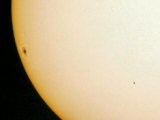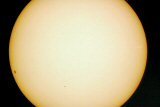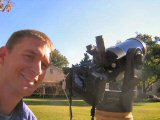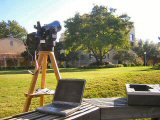11.08.06 - Mercury Transit

If you have a sharp eye you can see the planet Mercury on the left - that a sunspot on the right |

Isn't it amazing to see the size of our Sun in compairson to the speck of the planet Mercury, and for compairson, Mercury is about the size of our moon! |

My self-portrait from campus, it was quite an ordeal to haul all the equipment down, but I'd rather not set up along the street |

Although I rarely get a chance to set up my telescope anymore, I still love it when I do - the wonders of Astronomy will always be a passion |
It only happens 16 times this century, and this is the second such event. Occasionally, when the Earth’s orbit and the orbit of Mercury coincide, when their delicately balanced planes of revolution line up with the sun, we see a Mercury eclipse.
Well to tell you the truth I don’t get to take out my telescope very often in Dallas (the city lights make the moon hard to see), so if ever the sun presents itself as a target, I have ample visibility in the great Texas sky to catch a good view.
This Mercury transit (when the planet traverses the disk of the sun) lasted only a few hours, but the viewing was great. During the last Mercury transit, in 2003, I only caught an edge of the planet’s path, but this time Mercury was much more centered.
I used a Canon 30D to capture the images on an extension T-mount, however my astrophotography is extremely poor and I don’t even know where to begin to capture images I can be proud of.
Just the same you’ll be able to see the tiny spot of Mercury as it passed between the Earth and Sun, along with a black sunspot on the far left. Sunspots are often areas of intense radiation and cooler temperatures on the Sun’s surface.
“The heavens declare the glory of God,” and the tiny cratered planet of Mercury, created to live in our solar system’s precision of exquisite craftsmanship, screamed the Creator’s glory as it blazed past our Sun.
I hope you enjoy the photographs, it was fun to have my telescope out on campus (a sight to see for sure), and remember to always use viewing protection when looking towards the Sun.

